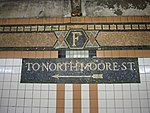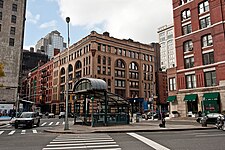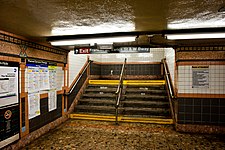Franklin Street station (IRT Broadway–Seventh Avenue Line)
Franklin Street | |||
|---|---|---|---|
 Northbound platform | |||
| Station statistics | |||
| Address | Franklin Street & Varick Street New York, NY 10013 | ||
| Borough | Manhattan | ||
| Locale | Tribeca | ||
| Coordinates | 40°43′08″N 74°00′25″W / 40.719°N 74.007°WCoordinates: 40°43′08″N 74°00′25″W / 40.719°N 74.007°W | ||
| Division | A (IRT)[1] | ||
| Line | IRT Broadway–Seventh Avenue Line | ||
| Services | 1 2 | ||
| Transit | |||
| Structure | Underground | ||
| Platforms | 2 side platforms | ||
| Tracks | 4 | ||
| Other information | |||
| Opened | July 1, 1918 | ||
| Station code | 326[2] | ||
| Opposite- direction transfer | No | ||
| Traffic | |||
| 2019 | 1,567,005[4] | ||
| Rank | 285 out of 424[4] | ||
| Station succession | |||
| Next north | Canal Street: 1 | ||
| Next south | Chambers Street: 1 | ||
| |||
| |||
| |||
| |||
Franklin Street is a local station on the IRT Broadway–Seventh Avenue Line of the New York City Subway, located at the intersection of Franklin Street, Varick Street, and West Broadway.[5] It is served by the 1 train at all times and by the 2 train during late nights.
The station was built by the Interborough Rapid Transit Company (IRT) as part of the Dual Contracts with New York City, and opened on July 1, 1918. The station had its platforms extended in the 1960s, and was renovated in the early 1990s.
History[]
Construction and opening[]



The Dual Contracts, which were signed on March 19, 1913, were contracts for the construction and/or rehabilitation and operation of rapid transit lines in the City of New York. The contracts were "dual" in that they were signed between the City and two separate private companies (the Interborough Rapid Transit Company and the Brooklyn Rapid Transit Company), all working together to make the construction of the Dual Contracts possible. The Dual Contracts promised the construction of several lines in Brooklyn. As part of Contract 4, the IRT agreed to build a branch of the original subway line south down Seventh Avenue, Varick Street, and West Broadway to serve the West Side of Manhattan.[6][7][8]
The construction of this line, in conjunction with the construction of the Lexington Avenue Line, would change the operations of the IRT system. Instead of having trains go via Broadway, turning onto 42nd Street, before finally turning onto Park Avenue, there would be two trunk lines connected by the 42nd Street Shuttle. The system would be changed from looking like a "Z" system on a map to an "H" system. One trunk would run via the new Lexington Avenue Line down Park Avenue, and the other trunk would run via the new Seventh Avenue Line up Broadway. In order for the line to continue down Varick Street and West Broadway, these streets needed to be widened, and two new streets were built, the Seventh Avenue Extension and the Varick Street Extension.[9] It was predicted that the subway extension would lead to the growth of the Lower West Side, and to neighborhoods such as Chelsea and Greenwich Village.[10][11]
Franklin Street opened as the line was extended south to South Ferry from 34th Street–Penn Station on July 1, 1918, and was served by a shuttle.[12] The new "H" system was implemented on August 1, 1918, joining the two halves of the Broadway–Seventh Avenue Line and sending all West Side trains south from Times Square.[13] An immediate result of the switch was the need to transfer using the 42nd Street Shuttle in order to retrace the original layout. The completion of the "H" system doubled the capacity of the IRT system.[10]
Station renovations[]
On August 9, 1964, the New York City Transit Authority (NYCTA) announced the letting of a $7.6 million contract to lengthen platforms at stations on the Broadway—Seventh Avenue Line from Rector Street to 34th Street–Penn Station, including Franklin Street, and stations from Central Park North–110th Street to 145th Street on the Lenox Avenue Line to allow express trains to be lengthened from nine-car trains to ten-car trains, and to lengthen locals from eight-car trains to ten-car trains. With the completion of this project, the NYCTA project to lengthen IRT stations to accommodate ten-car trains would be complete.[14]
The station was renovated in the early 1990s.[citation needed]
When Aretha Franklin died on August 16, 2018, the Metropolitan Transportation Authority put temporary sticker signs on the walls with the word "Respect" on them. They were only supposed to be up for six months but as of March 2021, they are still on the walls.
Station layout[]


| G | Street level | Exit/entrance |
| P Platform level |
Side platform | |
| Northbound local | ← ← | |
| Northbound express | ← | |
| Southbound express | | |
| Southbound local | | |
| Side platform | ||
The station has two side platforms and four tracks with no crossover or crossunder. The center tracks are used by the 2 and 3 express trains during daytime hours.[15]
There are "store window"-style art displays on the southbound platform and a faux-newsstand on the northbound side.[15] Although the station's original wall tiling was replaced during renovations, its mosaic bands were kept; there are "Franklin Street" large mosaics, small "F" mosaics and directional mosaics "To Franklin St." and "To North Moore St."[15] The floor tiles are rose and tan colored with light and dark splotches.[15]
Exits[]
The full-time entrance is on the uptown side, on a traffic island where Varick Street and West Broadway meet.[16] There is a kiosk reminiscent of the original IRT kiosks at 72nd Street and Bowling Green, but it was added during the station's renovation during the mid-1990s.[15] There are two downtown street stair entrances on either western corner of Varick and Franklin Streets, but the booth is not staffed at all times. There are part-time high-exit turnstiles one block north, at both northern corners of Varick and North Moore Streets, on both the uptown and downtown sides.[16]
References[]
- ^ "Glossary". Second Avenue Subway Supplemental Draft Environmental Impact Statement (SDEIS) (PDF). 1. Metropolitan Transportation Authority. March 4, 2003. pp. 1–2. Archived from the original (PDF) on February 26, 2021. Retrieved January 1, 2021.
- ^ "Station Developers' Information". Metropolitan Transportation Authority. Retrieved June 13, 2017.
- ^ "Facts and Figures: Annual Subway Ridership 2014–2019". Metropolitan Transportation Authority. 2020. Retrieved May 26, 2020.
- ^ Jump up to: a b "Facts and Figures: Annual Subway Ridership 2014–2019". Metropolitan Transportation Authority. 2020. Retrieved May 26, 2020.
- ^ 1 Broadway - Seventh Avenue Line Local line map Archived May 9, 2008, at the Wayback Machine MTA Retrieved May 20, 2008
- ^ "Terms and Conditions of Dual System Contracts". nycsubway.org. Public Service Commission. March 19, 1913. Retrieved February 16, 2015.
- ^ "The Dual System of Rapid Transit (1912)". nycsubway.org. Public Service Commission. September 1912. Retrieved May 30, 2017.
- ^ "Most Recent Map of the Dual Subway System Which Shows How Brooklyn Borough Is Favored In New Transit Lines". The Brooklyn Daily Eagle. September 9, 1917. p. 37. Retrieved August 23, 2016 – via Brooklyn Public Library; newspapers.com.
- ^ Engineering News-record. McGraw-Hill Publishing Company. 1916.
- ^ Jump up to: a b Whitney, Travis H. (March 10, 1918). "The Seventh and Lexington Avenue Subways Will Revive Dormant Sections" (PDF). The New York Times. p. 12. ISSN 0362-4331. Retrieved August 26, 2016.
- ^ "Public Service Commission Fixes July 15 For Opening of The New Seventh and Lexington Avenue Subway Lines" (PDF). The New York Times. May 19, 1918. p. 32. ISSN 0362-4331. Retrieved November 6, 2016.
- ^ "Open New Subway to Regular Traffic" (PDF). The New York Times. July 2, 1918. p. 11. ISSN 0362-4331. Retrieved November 6, 2016.
- ^ "Open New Subway Lines to Traffic; Called a Triumph" (PDF). The New York Times. August 2, 1918. p. 1. ISSN 0362-4331. Retrieved April 21, 2020.
- ^ "IRT Riders To Get More Train Room; $8.5 Million Is Allocated for Longer Stations and for 3 New Car Washers". The New York Times. August 10, 1964. ISSN 0362-4331. Retrieved January 4, 2021.
- ^ Jump up to: a b c d e "IRT West Side Line: Franklin Street". nycsubway.org. Retrieved May 20, 2008.
- ^ Jump up to: a b "MTA Neighborhood Maps: SoHo / Tribeca" (PDF). Metropolitan Transportation Authority. 2015. Retrieved August 6, 2015.
External links[]
| Wikimedia Commons has media related to Franklin Street (IRT Broadway – Seventh Avenue Line). |
- nycsubway.org – IRT West Side Line: Franklin Street
- nycsubway.org – Alleyways, Tribeca Artwork by Susan Leopold (2005)
- Station Reporter – 1 Train
- Franklin Street entrance from Google Maps Street View
- Varick Street and West Broadway entrance from Google Maps Street View
- Moore Street exit only stairs from Google Maps Street View
- Platforms from Google Maps Street View
- 1918 establishments in New York (state)
- IRT Broadway–Seventh Avenue Line stations
- New York City Subway stations in Manhattan
- Railway stations in the United States opened in 1918
- Tribeca
- New York City Subway stations located underground




